The installation of a clothesline is dependent on its type and location.
The typical or traditional clothesline consists of ropes or strings placed in a straight line between two posts, such as trees, a house, two poles, or a combination of accessible places.
The ropes should be mounted above the floor at your head level or to your comfort, with just enough support to hold them securely from both ends.
Once you’ve selected two suitable spots, you can simply secure the ropes there; i.e., they can be tied around the poles or knotted over screws or hooks fixed on the opposing walls.
Key Takeaways
- A standard clothesline is made by tying ropes at two points so that clothes can be hung over them for air drying.
- Clotheslines are also available in the form of a hanging rack, i.e. a rectangular frame that includes a set of long pipes to hang dry your garments.
- Another popular type is the retractable clothesline, which can be mounted on a wall or fence. These lines are great for small yards or balconies where space is limited.
- Out of all the available options, the traditional clothesline that uses ropes can be installed in multiple places (spaces such as your balconies, garden areas, terraces, or laundry rooms).
How to install a clothesline?
Different types of clotheslines may require other installation methods.
For example, a retractable clothesline is installed by first drilling holes in the wall or fence where it will be mounted. The clothesline is then inserted into the holes and screwed in place. In contrast, a traditional clothesline can be installed by simply tying the knots on two opposite ends.
This type of clothesline is generally easier to install and can be done without any special tools.
Let’s take a quick look at different ways to install a clothesline depending on its type.
Standard Clothesline using ropes or strings
The standard clothesline refers to the ropes stretched above ground level between two points in a straight line.
You can mount the ropes according to the available space and the location of the two spots.
This air drying method has been used for ages and is found in almost every household these days.
It doesn’t matter if someone owns an electric clothes dryer, a clothesline still becomes a must-have drying tool in the laundry rooms as not all fabrics are made the same.
Let’s look at the numerous ways to use ropes or strings as a clothesline, along with different mounting options.
Between two walls
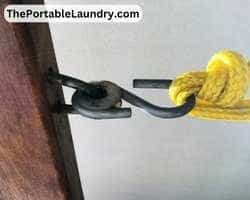
This is the most common and simple way to install a clothesline using ropes or strings.
Measure the height as per your comfort and mark points on the opposite walls.
It can be on your balcony or on the walls in the laundry room.
Drill and fix hooks or screws to the marked points on the opposite walls.
Now, tie or knot the ropes in a straight line on either end.
Start tying the ropes from one end and stretch them firmly to knot them at the other point.
You can drill multiple hooks, one beside the other, for multiple lines.
Doing this will help you dry a larger load of laundry in one place.
Another workaround is to use wooden or metal bars and screw multiple hooks over them.
For wooden bars, you can use a hardware drill; likewise, for metal bars, you will have to get the hooks welded over the metal frames.
You can even buy a pair of clothesline bars with multiple hooks online or at a local store.
These frames can be fixed by screwing them over the walls. Just make sure you measure the height evenly before placing them on opposing walls.
T-Post Clotheslines

T-post clotheslines are made up of two parallel rods (T-shaped) connected with many vinyl-covered lines (ropes or strings).
These types of clotheslines are suitable for households with larger family members who need to dry their daily laundry.
The rods in a T-shape clothesline are often made of stainless steel or rust-proof metals, meaning that they can withstand a variety of weather conditions.
Additionally, this clothesline is firmly planted in the ground, so you won’t have to worry about your clotheslines blowing over to your neighbor’s farm during a severe storm.
You can get a pair of T-Post poles dug into the ground or mount them using nuts over ring plates or square plates at their bases.
You can fix them in the garden area or in the yards.
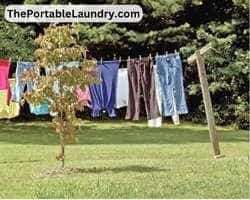
These can also be fixed on the terrace or any open space around your house.
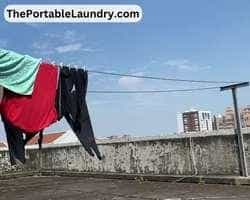
Pulleys
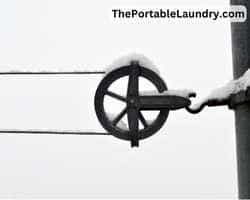
Some people use pulley systems to align ropes on either point and using this method for clotheslines has its own benefits.
You can hang your garments over the ropes by standing at one end.
It’s easy to hang the clothes one by one by dragging the ropes without having to move with the hefty bucket.
You can hook the pulleys on your balconies or to the outer walls and align the ropes accordingly over them.
Or you may also install them over poles, as shown in the image below.
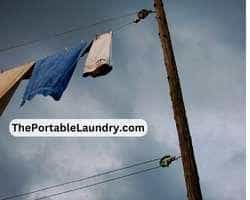
Wall mounted frames or hanging racks
There are other types of clotheslines available that have replaced the use of ropes and strings.
These types of clotheslines are made using stainless steel or plastic pipes mounted in a rectangular frame, also known as hanging racks.
These frames are mounted overhead using nuts or screws to the opposite walls dedicated to a clothesline.
Wall-mounted clotheslines usually come in two types, such as a fixed frame and a foldable one for wall mounting.
Mounting
Fixed frames are usually mounted to the opposite-facing walls in balconies or laundry rooms.
These are designed according to the space available in a given area between two walls.
Foldable frames can be fixed to a single wall, and you can fold or bend them towards the wall after every use.
To fix these types of clotheslines, mark and drill the spots above the walls before screwing them securely.
If your apartment lacks space, then simply mount them on the outer walls near the windows.
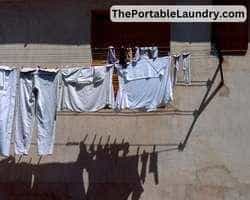
Retractable Clotheslines
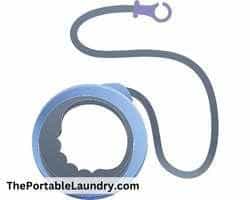
With a retractable clothesline, you can hang your clothes wherever you want. This type of clothesline cord is great for drying clothes both inside and outside, like in yards, balconies, basements, gardens, and other places.
In most cases, these are round or rectangular housings or units that hold retractable wires. You can attach the unit to one point and pull the retractable ropes out to connect to the other end.
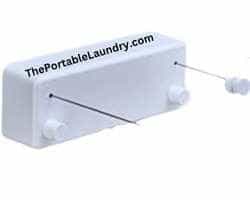
The best part is that when you are finished drying your laundry, you can just remove the line and clear up the space.
A retractable clothesline is very practical for those who have very little space around the house.
These retractable units come with one or more lines that can be stretched for multiple lines to dry excess laundry.
So, you can choose from a variety of retractable clotheslines as per the rope’s length, the number of lines, and the mounting space.
Mounting
Most of the time, the housing for these clotheslines is attached to the wall, and the retractable wires can be attached to hooks on the opposite walls or poles.
Once your garments are dry, you can unlock the wires from the opposite ends and the main unit pulls them off their way.
To install a retractable clothesline, simply find a spot where you can mount it and drill holes to accommodate the unit. Next, drill a hole on the opposite end, i.e., a wall or tree at an even height, so that you can install a hook.
Next, pull out the retractable wire from the unit and attach it to the hook.
Things to remember when you install a clothesline
There are certain things to keep in mind while you install or use a clothesline to air dry your garments.
- The ropes you will use for a clothesline to dry your garments should be water-resistant, such as nylon or plastic.
- Choosing the right space for air drying your fabrics is very important before you install a clothesline, such as a space in your garden, balcony, terrace, or laundry room.
- If you put up a clothesline under a tree in your garden, be ready for bird droppings like bird poop. If this happens, you will need to spot clean the garments at the earliest.
- For hanging racks, wall-mounted frames, pulleys, hooks, or retractable clotheslines, make sure you fix their bases firmly to the walls so that they do not fall off after you load your wet garments.
Final Thoughts
When compared to electric dryers, a clothesline is an easiest and most damage-free way to dry your clothes.
Moreover, the air drying method can help you reduce your monthly energy bills by avoiding clothes dryers.
Just make sure to use a clothespin to secure your garments while they dry on the clothesline.
Lastly, if your apartment lacks space, you can choose a space-saving option such as a hanging rack to dry your clothes.
Frequently Asked Questions
How far off the ground should a clothesline be?
In general, placing the clothesline 100mm above your head height should be ideal. With that said, the average height of a clothesline is around 6 feet and can be adjusted according to your convenience.
How deep should a clothesline pole be?
As a general rule of thumb, installing a clothesline pole in an 18 to 24 inch deep hole should be sufficient.
How far apart should clotheslines be?
The clotheslines should be placed 10 to 15 feet apart for optimal use and should not exceed 40 feet. Anything beyond 40 to 50 feet will cause the ropes to sag.
Do clotheslines need to be in the sun?
Line-drying is best done in sunny and dry weather, as clothes dry faster in these conditions.
You May Also Like
- How to Install a Clothesline Tightener? (Step-by-Step)
- How to Hookup a portable washer to the sink?
- How To Clean Car Carpet Without Extractor? (Comprehensive)
- How To Loosen Washing Machine Hose Safely? (Easy Guide)
- How to put Fabric Softener in a Washing Machine?
- How to Wash Allbirds Shoes? (Step-by-Step)
- How to Wash a Pillow Pet? (Step-by-Step)
- Five Stages Of Laundry Process (Explained)
- Laundry Bags: 11 Commonly Asked Questions Answered





